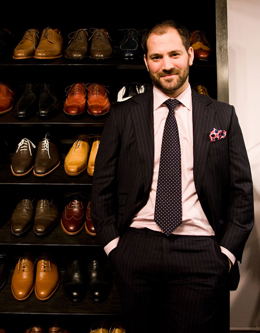Your Next Tailor
What I noticed first about Mantegna was his butt. He was wearing black and white striped pants and right along the seam of his rear, the thick white stripes were perfectly matched up, a sign of well-tailored pants. I followed the arrows up to his purple-striped shirt and the broad shoulders that filled them out. Two beers sat atop a table nearby, so I assumed Mantegna’s client would be relaxed as the tailor deftly fit an L-square ruler between his legs to measure his pelvis.
Other tricks for taking measurements include having the client put his heels together and spread his feet at 45-degree angles, to see if he is bow-legged or knock-kneed. Mantegna often uses tools to measure the slope of a client’s shoulders and his pitch—that is, whether he leans too far forward or backward when standing. There are other subtleties that Mantegna has learned to spot when taking a client’s measurements. He knows immediately when a client is sucking in his gut, or flexing a bicep. “Generally you learn when people are tensing up, and so what we’ll do is we’ll take the measurements, let them relax a bit, and take the measurements again when they’re not paying attention,” he said. “If it’s someone’s first time being measured they might tense up a little bit, but that’s why we give them a couple of beers—to get them in a relaxed state.”
On a recent afternoon, I sat in on fittings, including one with a client who was ordering shirts. The television was playing “Law & Order,” an ironic echo of Mantegna’s previous profession. A client, Tyler Rindler, came in and everyone—Mantegna, Shaw, and Marian Galam, 28, the administrative person—said hello. Shaw put a bunch of swatch books on the table and Rindler sifted through them, folding the fabric into a tab for the ones he liked. He chose a spread collar, rounded French cuffs for one of the shirts, pockets for all of them and monograms for none of them. Rindler said a friend referred him and even though he’s had custom clothes made elsewhere in New York, he favors Michael Andrews because they offer better craftsmanship, better material, a more professional atmosphere and a wider selection of fabrics. In terms of atmosphere, I couldn’t imagine one that was less professional, but so be it.
Mantegna’s next client came in wearing workout clothes, and proceeded to change into two suits he ordered two weeks ago, just in from China—one a light tan and the other a more traditional dark navy pinstripe. Once the client had changed, Mantegna’s eyes at once drifted to the wrinkles and imperfections in fit while his hands attacked them and deftly made chalk marks on the fabric. He pinched and prodded excess fabric around the armholes and even approached the client’s butt, where he pinched a tiny amount of excess fabric between the cheeks. At the end of the fitting, he took a ruler and made marks on the pant legs from the ground, to make sure that the hems were perfectly straight and not influenced by a tilt in the man’s hips.
A third client came in and invited everyone to his party that weekend. Mantegna told him about his plans to go to Florida with his girlfriend that same weekend. Then he began searching the Internet for a new apartment. While he browsed and shouted out occasional remarks about how low the prices were, I tried to excuse myself from the interview. After I’d tried a few times, Galam, Mantegna’s petite Asian staffer, like an assertive mother, told him that I was leaving. We shook hands and I left the den, thinking about how out of place I had felt. The first time I was there I had been wearing a skirt. That day even Galam was sporting a pair of jeans with intricate embroidery on the pockets.
I made a sharp right out the door and walked into the bathroom. Alas, the seat was up.

